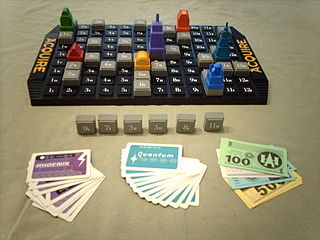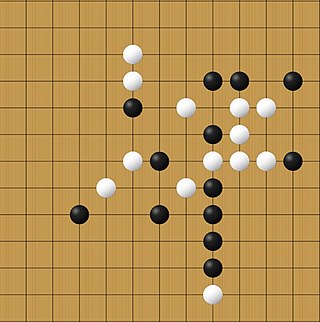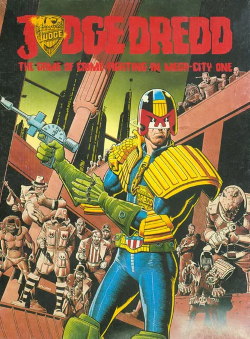
Acquire is a board game published by 3M in 1964 that involves multi-player mergers and acquisitions. It was one of the most popular games in the 3M Bookshelf games series published in the 1960s, and the only one still published in the United States.

Chinese checkers (US) or Chinese chequers (UK) is a strategy board game of German origin that can be played by two, three, four, or six people, playing individually or with partners. The game is a modern and simplified variation of the game Halma.

Pente is an abstract strategy board game for two or more players, created in 1977 by Gary Gabrel. A member of the m,n,k game family, Pente stands out for its custodial capture mechanic, which allows players to "sandwich" pairs of stones and capture them by flanking them on either side. This changes the overall tactical assessments players face when compared to pure placement m,n,k games such as Gomoku.

Reversi is a strategy board game for two players, played on an 8×8 uncheckered board. It was invented in 1883. Othello, a variant with a fixed initial setup of the board, was patented in 1971.

Abalone is a two-player abstract strategy board game designed by Michel Lalet and Laurent Lévi in 1987. Players are represented by opposing black and white marbles on a hexagonal board with the objective of pushing six of the opponent's marbles off the edge of the board.
Rail Baron is a railroad board game for 3 to 6 players.

Havannah is a two-player abstract strategy board game invented by Christian Freeling. It belongs to the family of games commonly called connection games; its relatives include Hex and TwixT. Havannah has "a sophisticated and varied strategy" and is best played on a base-10 hexagonal board, 10 hex cells to a side.

TwixT is a two-player strategy board game, an early entrant in the 1960s 3M bookshelf game series. It became one of the most popular and enduring games in the series. It is a connection game where players alternate turns placing pegs and links on a pegboard in an attempt to link their opposite sides. While TwixT itself is simple, the game also requires strategy, so young children can play it, but it also appeals to adults. The game has been discontinued except in Germany and Japan.
Crossings is a two-player abstract strategy board game invented by Robert Abbott. The rules were published in Sid Sackson's A Gamut of Games. Crossings was the precursor to Epaminondas, which uses a larger board and expanded rules.

Advance to Boardwalk is a 1985 spin-off of the Parker Brothers board game Monopoly.

Good & Bad Ghosts or Ghosts! is a supernatural horror board game designed by Alex Randolph for two players, and published in 1982 by Milton Bradley. Players navigate their ghosts across a board to either escape through one of the exits or capture all of their opponent's good ghosts, although which ghosts are good and which are evil are kept secret from the opposing player.

There are many variations of the simple rules of Go. Some are ancient digressions, while other are modern deviations. They are often side events at tournaments, for example, the U.S. Go Congress holds a "Crazy Go" event every year.

Judge Dredd, subtitled "The Game of Crime-Fighting in Mega-City One", is a board game published by Games Workshop (GW) in 1982 that is based on the dystopian comic series Judge Dredd that appeared in the British comic magazine 2000 AD. It was designed by Ian Livingstone, the co-founder of Games Workshop.
Three-player chess is a family of chess variants specially designed for three players. Many variations of three-player chess have been devised. They usually use a non-standard board, for example, a hexagonal or three-sided board that connects the center cells in a special way. The three armies are differentiated usually by color, with White, Black, and Red serving as the most common color combination.
A connection game is a type of abstract strategy game in which players attempt to complete a specific type of connection with their pieces. This could involve forming a path between two or more endpoints, completing a closed loop, or connecting all of one's pieces so they are adjacent to each other. Connection games typically have simple rules, but complex strategies. They have minimal components and may be played as board games, computer games, or even paper-and-pencil games.

Hex is a turn-based strategy game developed by Mark of the Unicorn and published in 1985 for the then-new Atari ST and later for the Amiga. The player controls a unicorn that is trying to turn all the hexes on the game board to the same colour. Opponents attempt to turn them to a different colour and thus defeat the unicorn. As the unicorn levels up, new spells are added to its repertoire, but only 5 can be used at any given time.
This glossary of board games explains commonly used terms in board games, in alphabetical order. For a list of board games, see List of board games; for terms specific to chess, see Glossary of chess; for terms specific to chess problems, see Glossary of chess problems.

Diamond is a two-player abstract strategy board game invented by Larry Back. The invention was inspired by the game Kensington, which uses a similar board pattern and game objective. Rules for Diamond were conceived in 1985 and finalized in 1994. Diamond introduces a new board geometry and neutral pieces, with the aim of enhancing the game dynamic and lowering the potential for draws.

Targui is a board game published in 1988 by Jumbo Games that simulates warfare between Touareg tribes of North Africa to acquire economically strong territories.
Domain is a tile-based abstract strategy game first published throughout Europe in 1982. Players place multicoloured polymino tiles on a game board and flip any of their opponent's pieces adjacent to them in order to have the most squares covered by their colour at the end of the game.
















